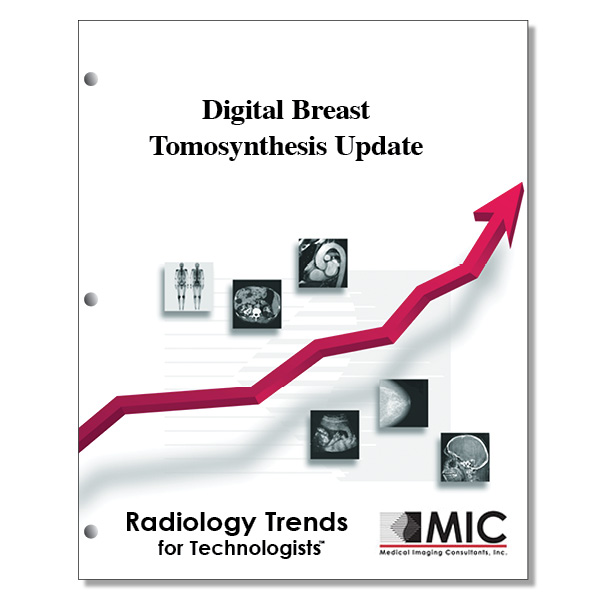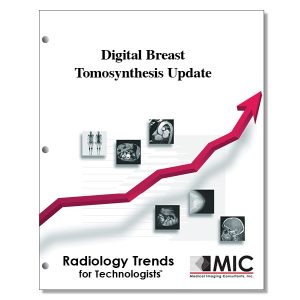

Digital Breast Tomosynthesis Update
Digital breast tomosynthesis (DBT) has allowed increased detection of cancer, but its long-term effect on mortality is currently unknown. The role of DBT is evaluated considering current practice guidelines, emerging data, and technical advances.
Course ID: Q00661 Category: Radiology Trends for Technologists Modality: Mammography2.25 |
Satisfaction Guarantee |
$24.00
- Targeted CE
- Outline
- Objectives
Targeted CE per ARRT’s Discipline, Category, and Subcategory classification:
[Note: Discipline-specific Targeted CE credits may be less than the total Category A credits approved for this course.]
Breast Sonography: 0.25
Patient Care: 0.25
Patient Interactions and Management: 0.25
Mammography: 2.25
Image Production: 1.00
Image Acquisition and Quality Assurance: 1.00
Procedures: 1.25
Mammographic Positioning, Special Needs, and Imaging Procedures: 1.25
Magnetic Resonance Imaging: 0.25
Procedures: 0.25
Body: 0.25
Registered Radiologist Assistant: 1.00
Procedures: 1.00
Thoracic Section: 1.00
Sonography: 0.25
Procedures: 0.25
Superficial Structures and Other Sonographic Procedures: 0.25
Radiation Therapy: 0.25
Patient Care: 0.25
Patient and Medical Record Management: 0.25
Outline
- Introduction
- Current Scope
- Screening Outcomes and Guidelines
- Cancer Detection Rates
- Mortality Benefit
- Multimodality Screening
- Screening Environment
- DBT Screening Guidelines
- Diagnostic Outcomes and Guidelines
- Reducing Additional Views
- Positive Predictive Value of Biopsy
- Architectural Distortion
- Workflow Efficiency
- DBT Diagnostic Guidelines
- Technical Considerations
- Synthetic Mammography
- Vendor Diversification
- Technical Innovations
- DBT Lexicon
- Conclusion
Objectives
Upon completion of this course, students will:
- recall the year that DBT was initially approved by the U.S. Food and Drug Administration
- list ongoing efforts to make improvements in DBT
- explain the efforts made by DBT vendors to improve breast imaging systems
- state the percentage of all accredited mammography units in the United States that had DBT capabilities by August 2020
- recall the year that dedicated Current Procedural Terminology codes for DBT became available
- interpret reference tables within the article to determine specific recall rates for digital mammography throughout different studies
- state the ultimate goal of breast cancer screening
- list the ways DBT helps detect different types of breast cancers
- describe outcomes of early data regarding DBT
- describe how tumors detected by DBT present
- list the characteristics of true interval cancers
- interpret data tables to determine the number of interval screening rounds performed in a given number of screening studies
- list potential outcomes of the Tomosynthesis Mammographic Screening Trial
- choose the imaging modality that is the most common supplemental modality used in women with dense breast tissue because of its wide availability
- state the risk factor of developing breast cancer in women with extremely dense breasts as compared to women with fatty breasts
- state how ultrasound screening after digital mammography can increase the cancer detection rate
- differentiate between multiple breast cancer clinical trials and their outcomes
- list the challenges associated with automated breast ultrasound
- state what percent of cancers are not detected with ultrasound or mammography despite increased cancer detection with supplemental ultrasound in addition to mammography
- state the sensitivity of magnetic resonance imaging in addition to digital mammography and ultrasound in the ACRIN 6666 trial
- describe imaging developments that will help expand the role of magnetic resonance imaging in breast cancer screening
- describe the cancer detection rates between Europe, Scandinavia, and the United States
- be familiar with the National Comprehensive Cancer Network screening mammography recommendations
- discuss how DBT has affected the need for additional views
- describe how the use of DBT in the diagnostic setting has reduced the need for additional imaging and interventions
- list the benefits of diagnostic examinations with DBT as compared with digital mammography
- explain the likelihood of malignancy in lesions recommended for biopsy
- state what imaging modality is best at demonstrating architectural distortions of the breast
- compare study outcomes related to breast architectural distortion
- discuss breast architectural distortion malignancy rates
- explain the difference in interpretation time between DBT and digital mammography
- discuss the current ACR appropriateness criteria in the United States for specific modality use in specific patient types
- explain the purpose of synthetic mammography
- list the FDA-approved DBT systems available in the United States
- state the year that the DBT supplement to the 2013 ACR BI-RADS manual on mammography was published
